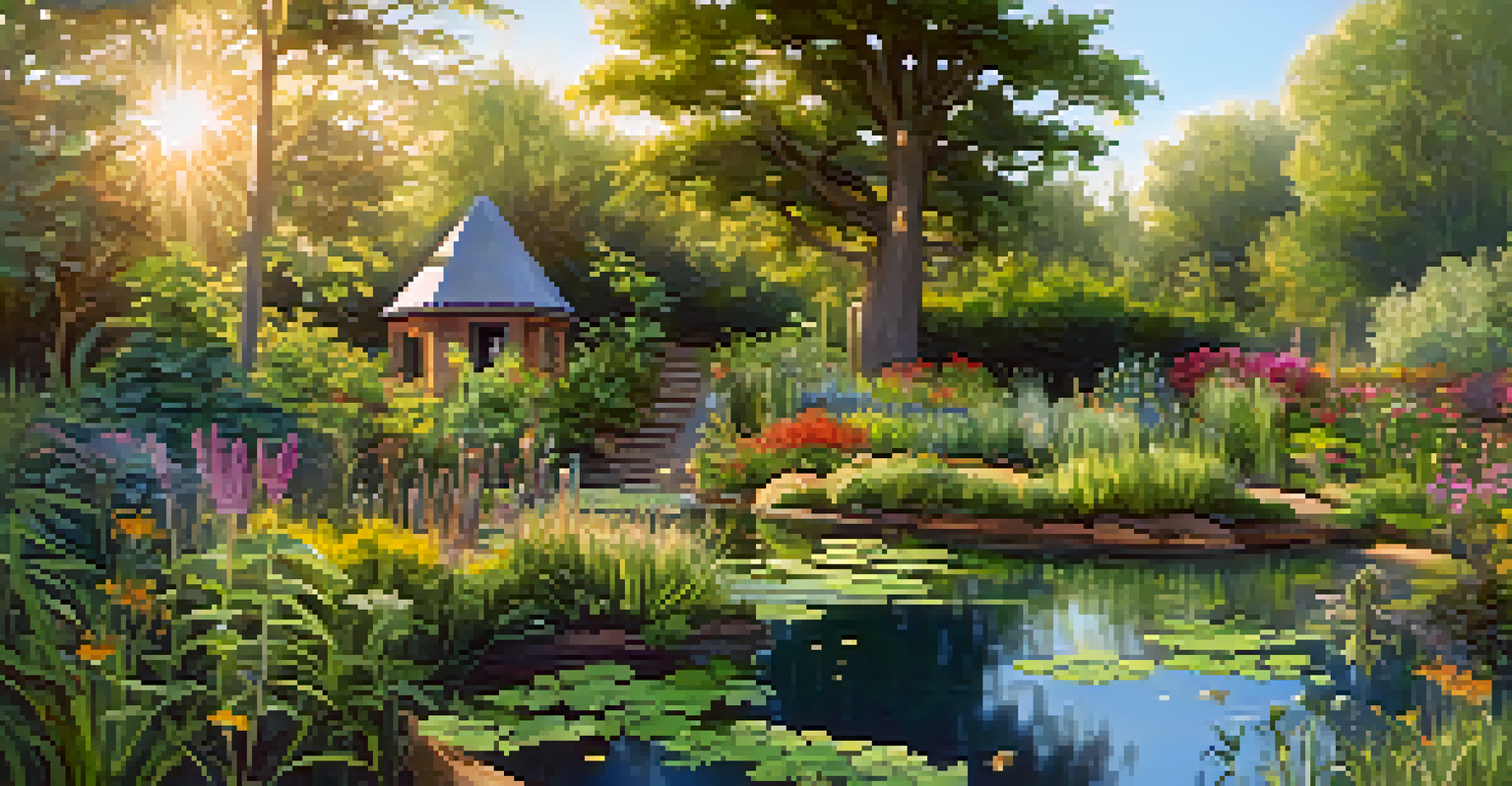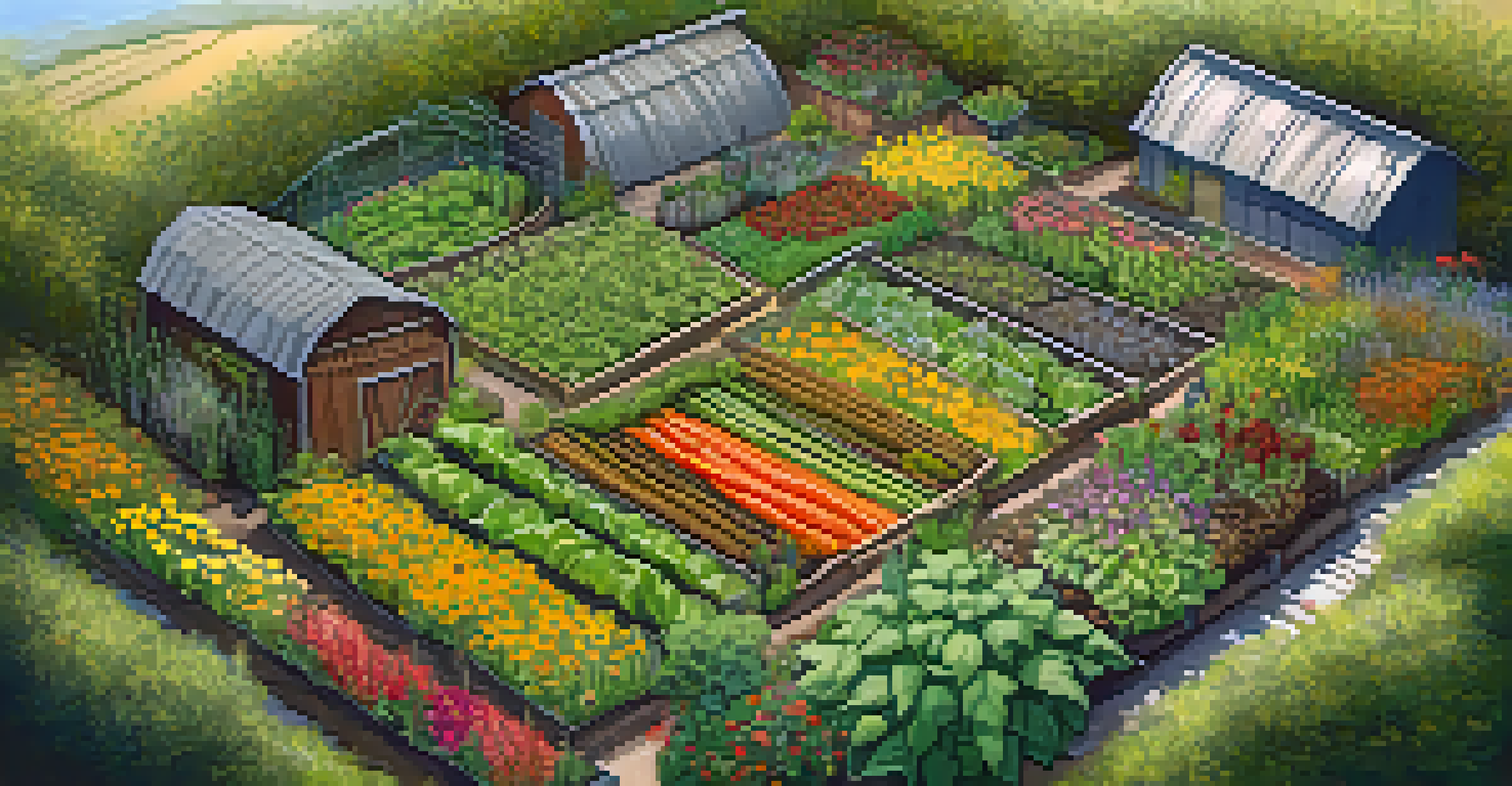Permaculture Principles: Designing Your Eco-Friendly Garden

Understanding Permaculture: A Sustainable Approach to Gardening
Permaculture is more than just a gardening method; it's a holistic system that aims to create self-sustaining ecosystems. By mimicking natural processes, permaculture encourages biodiversity and reduces waste, making it an eco-friendly alternative to conventional gardening. This approach can transform your garden into a thriving habitat that supports both plants and wildlife.
The greatest threat to our planet is the belief that someone else will save it.
At its core, permaculture principles focus on working with nature rather than against it. For instance, by observing how ecosystems function, you can design your garden to use resources efficiently, conserve water, and enhance soil health. This leads to a more resilient garden that requires less maintenance over time.
By adopting permaculture in your garden, you're not only cultivating plants but also fostering a deeper connection with nature. It invites you to see your outdoor space as part of a larger ecosystem, encouraging a mindset shift that emphasizes sustainability and stewardship.
The Principle of Observation: Learning from Your Environment
Observation is a foundational permaculture principle that empowers gardeners to understand their unique environment. Spend time watching how sunlight, water, and wind interact within your garden space. This knowledge will inform your design choices and help you identify the best plants for your specific conditions.

By observing local wildlife and plant growth, you can learn about natural cycles and relationships. For example, seeing which plants attract beneficial insects can guide you in creating a more balanced ecosystem. This attention to detail allows for informed decisions that enhance biodiversity and productivity.
Permaculture: Sustainable Gardening
Permaculture creates self-sustaining ecosystems by mimicking natural processes, promoting biodiversity, and reducing waste.
Ultimately, the principle of observation teaches us to become more intuitive gardeners. Rather than forcing a specific design, we learn to adapt our gardens to fit the natural rhythms and dynamics of our surroundings, leading to a more harmonious and sustainable landscape.
Embracing Diversity: The Importance of Biodiversity in Gardens
Diversity is a key tenet of permaculture that promotes resilience and stability in your garden ecosystem. By planting a variety of species, you reduce the risk of pest infestations and diseases, as not all plants will be equally affected. This diversity creates a balanced environment where beneficial insects and pollinators can thrive.
Nature does not hurry, yet everything is accomplished.
Incorporating various plants, such as perennials, annuals, and cover crops, adds layers to your garden. Each layer serves a purpose, from providing food for humans and wildlife to improving soil health and preventing erosion. This interconnectedness mimics natural ecosystems, where every organism plays a role in maintaining balance.
By embracing diversity in your garden, you're not just growing food; you're cultivating a vibrant ecosystem. This approach encourages a deeper appreciation for nature and its complexities, reminding us that a healthy garden is one that reflects the rich tapestry of life.
Using Zones: Efficient Design for Your Eco-Friendly Garden
The concept of zones in permaculture helps you design your garden for maximum efficiency. By organizing your space into zones based on how frequently you need to access different areas, you can streamline your gardening tasks. For instance, placing herbs and vegetables you use regularly closer to your kitchen reduces unnecessary walking.
Each zone can be tailored to specific needs, with the innermost zones reserved for high-maintenance plants that require daily attention. As you move outward, the zones can include less demanding plants or even wild areas that support biodiversity. This thoughtful arrangement not only saves time but also promotes a more sustainable approach to gardening.
Observation for Garden Design
The principle of observation empowers gardeners to understand their environment and make informed design choices based on natural cycles.
By utilizing zones in your garden design, you create a functional and enjoyable space that encourages frequent interaction. This not only enhances your gardening experience but also fosters a deeper connection with nature and your food sources.
Soil Health: The Foundation of a Thriving Garden Ecosystem
Healthy soil is the cornerstone of any successful garden, and permaculture emphasizes practices that nourish the earth. Techniques like composting and mulching enrich the soil with organic matter, promoting beneficial microbial activity. This, in turn, leads to better water retention and nutrient availability for your plants.
Incorporating cover crops is another effective way to enhance soil health. These plants protect the soil from erosion, suppress weeds, and, when turned into the ground, add nutrients back into the soil. By focusing on soil health, you create a robust foundation that supports the entire ecosystem of your garden.
Ultimately, investing in soil health is an investment in the future of your garden. As your soil becomes more fertile and resilient, you'll notice improved plant growth and a more vibrant ecosystem, making your garden a thriving sanctuary.
Water Management: Sustainable Practices for Your Garden
Water management is crucial for creating an eco-friendly garden, and permaculture offers several strategies to conserve this precious resource. Techniques like rainwater harvesting and swales help capture and retain water, minimizing waste and ensuring plants have access to moisture during dry spells. These practices not only support your plants but also reduce your reliance on municipal water supplies.
Incorporating drought-resistant plants can further enhance your garden's resilience to changing climate conditions. By selecting native species that thrive in your local environment, you create a garden that requires less irrigation and maintenance. This not only benefits your garden but also supports local ecosystems.
Enhancing Soil Health Matters
Healthy soil is crucial for a thriving garden, and practices like composting and cover cropping enrich the ecosystem.
By prioritizing sustainable water management practices, you create a garden that works in harmony with nature. This thoughtful approach not only conserves resources but also cultivates a deeper connection to the water cycle and the environment.
Creating a Wildlife Habitat: Supporting Local Ecosystems
One of the most rewarding aspects of permaculture is the opportunity to create a habitat for local wildlife. By incorporating native plants, you provide food and shelter for birds, bees, and beneficial insects. This fosters biodiversity and supports the ecological health of your garden and surrounding area.
Adding elements like water features, birdhouses, and insect hotels can further enhance your garden's appeal to wildlife. These features create safe spaces for creatures to thrive, encouraging them to visit and play vital roles in pollination and pest control. Your garden becomes a sanctuary for both plants and animals, contributing to a balanced ecosystem.

Ultimately, designing your garden with wildlife in mind enriches your gardening experience. You'll witness the beauty of nature up close and develop a deeper appreciation for the interconnectedness of all living things.